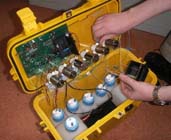New chemical sensors to make remote explosive detection easier
 Washington, April 10 : Researchers at the University of Michigan in US are developing chemical sensors that would make it safer and easier to detect remote roadside bombs.
Washington, April 10 : Researchers at the University of Michigan in US are developing chemical sensors that would make it safer and easier to detect remote roadside bombs.
Being developed by a team led by chemistry professor Theodore Goodson III, the materials can sniff out TNT and give off signals that can be detected remotely.
The materials under study are large macromolecules made up of smaller active parts (chromophores), put together in a branching pattern.
“When TNT vapor contacts the material, the TNT gets caught in the branches, as if in a sieve,” said Goodson.
Normally, these materials emit light (fluoresce) when their molecules are excited with pulses of infrared light. But even the slightest trace of TNT quenches that fluorescence.
Goodson envisions a system in which sensors, which can be made for about 10 dollars each, are positioned along the roadside and in other important locations.
Passing military vehicles would be equipped with lasers to shoot infrared light at the sensors to excite the fluorescence and a specially designed light-collection system to detect the sensors’ response.
Any sensors that don’t fluoresce would be tip-offs to possible locations of roadside bombs.
Goodson’s remote detection scheme relies on highly sensitive, low-cost, battery-free, thin film sensors that require no electronic equipment or excitation source at the sites where they are installed.
In contrast, conventional chemical TNT sensors for explosive detection have no remote capability and must be used in close proximity to the suspicious site, increasing the danger for military personnel.
Using infrared light to excite the remote sensors minimizes light-scattering, allows for greater penetration through the atmosphere, and is safe to soldiers’ eyes.
Goodson’s research team also is working on laser-based methods for directly detecting TNT, with no sensors on site. (ANI)